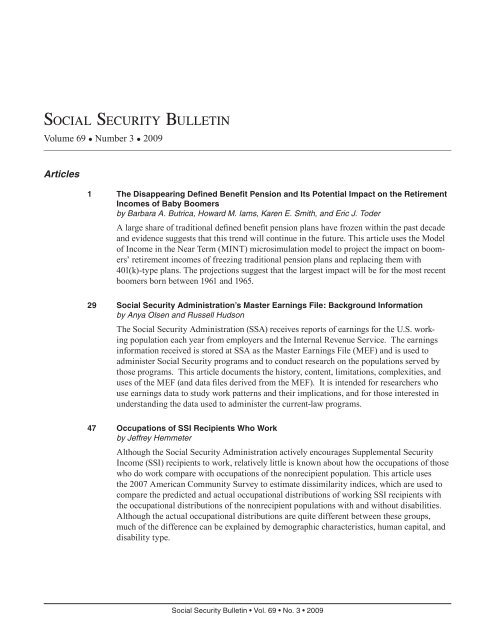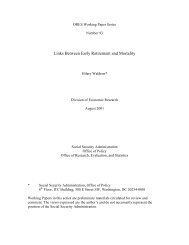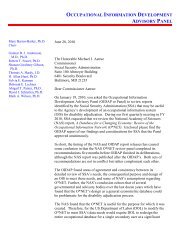Download entire publication - Social Security
Download entire publication - Social Security
Download entire publication - Social Security
You also want an ePaper? Increase the reach of your titles
YUMPU automatically turns print PDFs into web optimized ePapers that Google loves.
<strong>Social</strong> <strong>Security</strong> BulletinVolume 69 ● Number 3 ● 2009Articles1 The Disappearing Defined Benefit Pension and Its Potential Impact on the RetirementIncomes of Baby Boomersby Barbara A. Butrica, Howard M. Iams, Karen E. Smith, and Eric J. ToderA large share of traditional defined benefit pension plans have frozen within the past decadeand evidence suggests that this trend will continue in the future. This article uses the Modelof Income in the Near Term (MINT) microsimulation model to project the impact on boomers’retirement incomes of freezing traditional pension plans and replacing them with401(k)-type plans. The projections suggest that the largest impact will be for the most recentboomers born between 1961 and 1965.29 <strong>Social</strong> <strong>Security</strong> Administration’s Master Earnings File: Background Informationby Anya Olsen and Russell HudsonThe <strong>Social</strong> <strong>Security</strong> Administration (SSA) receives reports of earnings for the U.S. workingpopulation each year from employers and the Internal Revenue Service. The earningsinformation received is stored at SSA as the Master Earnings File (MEF) and is used toadminister <strong>Social</strong> <strong>Security</strong> programs and to conduct research on the populations served bythose programs. This article documents the history, content, limitations, complexities, anduses of the MEF (and data files derived from the MEF). It is intended for researchers whouse earnings data to study work patterns and their implications, and for those interested inunderstanding the data used to administer the current-law programs.47 Occupations of SSI Recipients Who Workby Jeffrey HemmeterAlthough the <strong>Social</strong> <strong>Security</strong> Administration actively encourages Supplemental <strong>Security</strong>Income (SSI) recipients to work, relatively little is known about how the occupations of thosewho do work compare with occupations of the nonrecipient population. This article usesthe 2007 American Community Survey to estimate dissimilarity indices, which are used tocompare the predicted and actual occupational distributions of working SSI recipients withthe occupational distributions of the nonrecipient populations with and without disabilities.Although the actual occupational distributions are quite different between these groups,much of the difference can be explained by demographic characteristics, human capital, anddisability type.<strong>Social</strong> <strong>Security</strong> Bulletin • Vol. 69 • No. 3 • 2009








